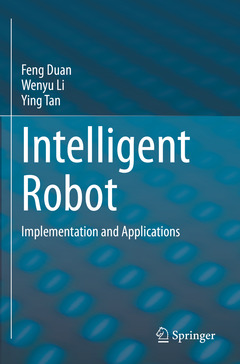Description
Intelligent Robot, 1st ed. 2023
Implementation and Applications
Authors: Duan Feng, Li Wenyu, Tan Ying
Language: English
Subject for Intelligent Robot:
Keywords
Robotics; artificial intelligence; service robot; control; automation
Publication date: 03-2024
290 p. · 15.5x23.5 cm · Paperback
Publication date: 02-2023
290 p. · 15.5x23.5 cm · Hardback
Description
/li>Contents
/li>Biography
/li>Comment
/li>
Chapter 1 Introduction to Robots.- Chapter 2 Getting Started with ROS.- Chapter 3 The framework of ROS.- Chapter 4 Programming with ROS.- Chapter 5 Introduction to Turtlebot Robot .- Chapter 6 Robot Vision: Theory and Implementation.- Chapter 7 Advanced Robot Vision.- Chapter 8 Robot Autonomous Navigation: Theory and Implementation.- Chapter 9 Robot Speech: Theory and Implementation.- Chapter 10 Robotic Hands, Grasping and Manipulation.- Chapter 11 Case 1: Long command recognition and multi-task execution.- Chapter 12 Case 2: Follow and assist the user.- Chapter 13 Case 3: Restaurant scenario: wave hand to order food.
Provides step-by-step robot development tutorials for beginners
Combines various development scenarios to show how to develop service robots
Suitable for students in robotics-related courses and beginners interested in intelligent robotics development




